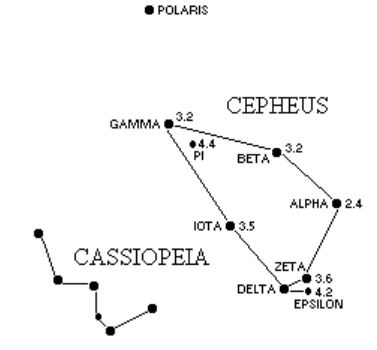Steve Baker wrote a very interesting piece about Delta Cephei in a recent newsletter. I have copied this here and added a bit more information about how to observe it. Never tried to do this myself … but it looks like an interesting short project.
Describing Delta Cephei
Delta Cephei is located in the circumpolar constellation of Cepheus (so visible all year round). It varies from magnitude 3.48 to 4.37, and its stellar classification also varies, from about F5 to G3. It is 2,000 times the Sun’s luminosity with a diameter between 32 and 35 that of our Sun and a period of 5 days 9 hours.
Cepheid variables provide the yard stick for measuring distances up to 100 million light years (Hubble has detected Cepheids in NGC4603 107mLy some away). This is thanks to painstaking work of Henrietta Swan Leavitt who in 1908 investigated of thousands of variable stars in the Magellanic Clouds. She established the relationship between the period and luminosity for classical Cepheids, thus enabling their use as standard candles and subsequently enabling Edwin Hubble to show that the Andromeda Nebula (Galaxy) was some 2.5mLy away.
Why its brightness varies
The pulsation occurs due to helium in the atmosphere. The intense radiation from the star doubly ionizes the helium (both electrons are stripped off) making it opaque so it appears to be dim. It also prevents the heat generated within the star from escaping. This causes the atmosphere to heat up further and expand. As is does so it cools; the cooling allows the helium to re-capture its electrons and become transparent again, so it appears brighter. The expansion and cooling also means the outward pressure of the gases reduces. Gravity is now the dominant factor and it pulls the atmosphere back and the whole process starts again.

How to find and observe Delta Cephei
Cepheus is, as Steve mentioned, a circumpolar constellation so it is visible all night and all year round. It sits between Cassiopeia and Draco with Gamma Cephei (the “top” star) being very close to the Pole Star. Delta Cephei is at the “bottom left” of the constellation, at RA 22.30h and its declination is about 58o which is about the same declination at the nearest “low” star in Cassiopei
There is in this area a very useful small triangle of stars : Delta Cephei, Epsilon Cephei and Zeta Cephei. Delta Cephei varies from slightly fainter than Zeta to slightly brighter than Epsilon. The complete cycle takes just over 5 days with a fairly gentle fading followed by a more abrupt brightening. I’ve never tried to observe this, but it would seem that with a reasonably consistent spell of clear weather you should be able to see it change.
When you use a telescope, you will also note that it has a companion star which is of 6th magnitude : a pretty pairing by all accounts!
Good luck with your observing.
The star map is taken from https://www.universetoday.com/20038/cepheus/ where you will find out much more information about it.
By Katherine Rusbridge
Aug 2019
